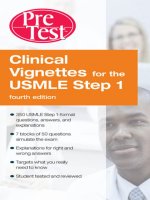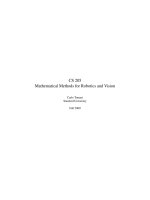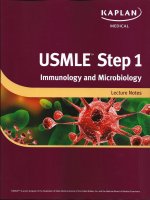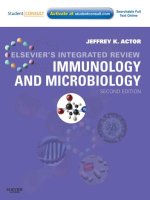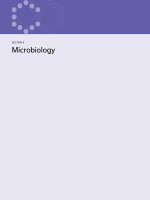Ebook USMLE Step 1 - Immunology and microbiology: Part 2
Bạn đang xem bản rút gọn của tài liệu. Xem và tải ngay bản đầy đủ của tài liệu tại đây (48.12 MB, 335 trang )
SECTION
Microbiology
General M icrobiology
1
What the USMLE Requires You To Know
•
Differences among viruses, fungi, bacteria, and parasites
•
Differences between eukaryotic and p roka ryotic cells
•
I m portant normal flora
•
Major mechanisms of pathogenicity
�
MEDICAL
1 99
Section II • Microbiology
MAJOR M ICROBIAL GROUPS
Table ll-1-1. Comparison of Medically Important Microbial Groups
Cell type
Acellular (not cell)
No n ucleus
Prokaryotic cells
DNA or RNA
DNA and RNA
1 n ucleocapsid except
in segmented or d iploid
viruses
1 chromosome
Replicates in host cells
Eukaryotic cells
N ucleus with n uclear membrane
Nucleoid region: no
nuclear membrane
D NA and RNA
More than 1 chromosome
No histones
G and S phases
DNA replicates continu
ously
Exons, no intrans
I ntrans and exons
Some have poly
cistronic m RNA***
and post translational
cleavage
Mono- and polycistronic
m RNA
Monocistronic RNA
Uses host organelles;
obligate intracellular
parasites
No membrane bound
organelles
No ribosomes
705
Replication
Make and assemble
viral com ponents
Binary fission (asexual)
Cellular membrane
Some are enveloped:
but n o membrane
function
Membranes have no sterols except Mycoplasmas,
which have cholesterol
Ergosterol is
major sterol.
Sterols such as cholesterol
Cell wall
No cell wall
Peptidoglycan
Complex carbo
hydrate cell wall:
chitin, glucans, or
mannans
No cell wall
Mitochondria and other membrane-bound organ
elles
SoS ribosomes (40S+60S)
ribosomes (30S+50S)
Cytokinesis with
m itosis/meiosis
*Besides viruses, two other aceltular forms exist:
•
Viroids: obligate intracellular but acellular parasites of plants; naked RNA; no human diseases.
•
Prions: acellular particles associated with Kuru, etc.; insensitive to nucleases.
Abnormal prion p roteins (PrP) modify folding of normal prion-like proteins found i n the body (coded for by human genes).
**If the diameter of a cell described i n a clinical case is >2 µ, then it is probably a eukaryotic cell.
***Polycistronic mRNA carries the genetic code for several p roteins. (It has multiple Shine-Dalgarno sites.)
200
� M E D ICAL
Chapter 1 • General Microbiology
Epidemiology
In a Nutshell
Definitions
Normal Rora
• Is found on body surfaces contiguous with the outside environment
Carrier: person colonized by a potential
pathogen without overt d isease.
• Can cause infection
Bacteremia: bacteria in bloodstream
without overt clinica l signs.
• Is semi-permanent, varying with major life changes
if misplaced, e.g., fecal flora to urinary tract or abdominal cavity, or skin
flora to catheter
or, if person becomes compromised, normal flora may overgrow (oral
thrush)
Septicemia: bacteria in bloodstream (mul
tiplying) with clinical sym ptoms.
• Contributes to health
protective host defense by maintaining conditions such as pH so other
organisms may not grow
serves nutritional function by synthesizing: K and B vitamins
Table ll-1-2. Important Normal Flora
Site
Common or Medically I mportant Organisms
Blood, internal organs
None, generally sterile
Cutaneous surfaces
including urethra and
outer ear
Staphylococcus epidermidis
Nose
Staphylococcus aureus
Less Common but Notable Organisms
Staphylococcus aureus,
Corynebacteria (di phtheroids), streptococci, an
aerobes, e.g., peptostreptococci,
yeasts (Candida spp.)
S. epidermidis, diphtheroids, assorted strepto
cocci
Oropharynx
Viridans streptococci including
Strep. mutans 1
Assorted streptococci, nonpathogenic Neisseria,
nontypeable2 Haemophilus influenzae,
Candida albicans
G ingival crevices
Anaerobes: Bacteroides, Prevotella, Fusobacte
rium, Streptococcus, Actinomyces
Stomach
None
Colon (microaerophilic/
a naerobic)
Bifidobacterium
Babies; breast-fed o n ly:
Lactobacillus, streptococci
Ad ult:
Bacteroides/Prevotella
(Predomina nt organism)
Escherichia
Bifidobacterium
Vagina
Lactobacillus 3
Eubacterium, Fusobacterium, Lactobacillus, as
sorted G ram-negative anaerobic rods, Enterococ
cus faeca/is and other streptococci
Assorted streptococci, gram-negative rods, diph
theroids, yeasts, Veil/one/la
15. mutans secretes a biofilm that glues it and other oral flora to teeth, producing dental plaque.
2Nontypeable for Haemophi/us means no capsule.
3Group B streptococci colonize vagina o f 1 5-20% of women and may infect the infant during labor or d elivery, causing septicemia and/or meningitis
(as may E. coli from fecal flora).
�
M E D I CA L
201
Section II • Microbiology
PATHOGENICITY (INFECTIVITY AND TOXICITY) MAJOR
MECHANISMS
Colonization
(Important unless organism is traumatically implanted.)
Adherence to cell surfaces involves
• Pili/fimbriae: primary mechanism in most gram-negative cells.
• Teichoic acids: primary mechanism of gram-positive cells.
• Adhesins: colonizing factor adhesins, pertussis toxin, and hemagglutinins.
• lgA proteases: cleaved Fe portion may coat bacteria and bind them to cel
lular Fe receptors.
Partial adherence to inert materials, biofilms: Staph. epidermidis, Streptococcus mutans
Avoiding Immediate Destruction by Host Defense System:
Note
• Anti-phagocytic surface components (inhibit phagocytic uptake):
Mnemonic
5treptococcus pneumoniae
!Sfebsiel/a pneumoniae
f!aemophilus influenzae
[!seudomonas aeruginosa
/l!eisseria meningitidis
£ryptococcus neoformans
- Capsules/slime layers:
Streptococcus pyogenes M protein
Neisseria gonorrhoeae pill
Staphylococcus aureus A protein
• lgA proteases, destruction of mucosal lgA: Neisseria, Haemophilus, S. pneu
moniae
(Some Killers ti.ave fretty Nice �apsules)
"Hunting and Gathering'' Needed Nutrients:
- Siderophores steal (chelate) and import iron.
Antigenic Variation
Note
Intracellular organisms
• Elicit different im mune responses
• Different pathology
• Different antibiotics
• Different culture tech niq ues
• Changing surface antigens to avoid immune destruction
•
N.
gonorrhoeae-pili and outer membrane proteins
• Trypanosoma brucei rhodesiense and
T.
b. gambiense-phase variation
• Enterobacteriaceae: capsular and flagellar antigens may or may not be
expressed
• HIV-antigenic drift
Ability to Survive lntracellularly
• Evading intracellular killing by professional phagocytic cells allows intra
cellular growth:
- M. tuberculosis survives by inhibiting phagosome-lysosome fusion.
- Listeria quickly escapes the phagosome into the cytoplasm before phagosome-lysosome fusion.
• Invasins: surface proteins that allow an organism to bind to and invade nor
mally non-phagocytic human cells, escaping the immune system. Best stud
ied invasin is on Yersinia pseudotuberculosis (an organism causing diarrhea).
• Damage from viruses is largely from intracellular replication, which either
kills cells, transforms them or, in the case of latent viruses, may do no
noticeable damage.
202
�
M E D I CA L
Chapter j, • General Microbiology
Type Ill Secretion Systems
• Tunnel from the bacteria to the host cell (macrophage) that delivers bacterial
toxins directly to the host cell
• Have been demonstrated in many pathogens: E. coli, Salmonella species,
Yersinia species, P aeruginosa, and Chlamydia
Inflammation or Immune-Mediated Damage
Examples
• Cross-reaction of bacteria-induced antibodies with tissue antigens causes
disease. Rheumatic fever is one example.
• Delayed hypersensitivity and the granulomatous response stimulated by
the presence of intracellular bacteria is responsible for neurological damage
in leprosy, cavitation in tuberculosis, and fallopian tube blockage resulting in
infertility from Chlamydia PID (pelvic inflammatory disease).
• Immune complexes damage the kidney in post streptococcal acute glomeru
lonephritis.
• Peptidoglycan-teichoic acid (large fragments) of gram-positive cells:
- Serves as a structural toxin released when cells die.
- Chemotactic for neutrophils.
Physical Damage
• Swelling from infection in a fixed space damages tissues; examples: meningitis
and cysticercosis.
• Large physical size of organism may cause problems; example: Ascaris
lumbricoides blocking bile duct.
• Aggressive tissue invasion from Entamoeba histolytica causes intestinal
ulceration and releases intestinal bacteria, compounding problems.
TOXINS
Toxins may aid in invasiveness, damage cells, inhibit cellular processes, or trigger im
mune response and damage.
Structural Toxins
• Endotoxin (Lipopolysaccharide
=
LPS)
- LPS is part of the gram-negative outer membrane.
- Toxic portion is lipid A: generally not released (and toxic) until death of
cell. Exception: N. meningitidis, which over-produces outer membrane
fragments.
- LPS is heat stable and not strongly immunogenic so it cannot be con
verted to a toxoid.
- Mechanism
0
0
0
LPS activates macrophages, leading to release of TNF-alpha, IL-1 ,
and IL-6.
IL-1 is a major mediator of fever.
Macrophage activation and products lead to tissue damage.
�
MED ICAL
203
Section II • Microbiology
0
Damage to the endothelium from bradykinin-induced vasodilation
leads to shock.
° Coagulation (DIC) is mediated through the activation of Hageman
factor.
• Peptidoglycan, Teichoic Acids
Exotoxins
• Are protein toxins, generally quite toxic and secreted by bacterial cells
(some gram +, some gram -)
• Can be modified by chemicals or heat to produce a toxoid that still is
immunogenic, but no longer toxic so can be used as a vaccine
• A-B (or "two") component protein toxins
B component binds to specific cell receptors to facilitate the internaliza
tion of A.
A component i.s the active (toxic) component (often an enzyme such as
an ADP ribosyl transferase).
Exotoxins may be subclassed as enterotoxins, neurotoxins, or cytotoxins.
• Cytolysins: lyse cells from outside by damaging membrane.
C. perfringens alpha toxin is a lecithinase.
- Staphylococcus aureus alpha toxin inserts itself to form pores in the
membrane.
204
�
M E D I CA L
Chapter 1 • General Microbiology
Table ll-1-3. Major Exotoxins
I n h ibitors
of Protein
Synthesis
I
Organism (Gram)
Toxin
Mode of Action
Role in Disease
Corynebacterium
diphtheriae (+)
Di phtheria toxi n
ADP ribosyl transferase;
inactivates eEF-2;
1' targets: heart/nerves/
epithelium
In hibits eukaryotic cell protein
synthesis
Pseudomonas aeruginosa (-)
Exotoxin A
ADP ribosyl transferase;
inactivates eEF-2;
1' target: liver.
I n h ibits eukaryotic cell protein
synthesis
I
Shigella dysenteriae
(-)
Shiga toxin
Interferes with 60S ribosoma! subun it
I n hibits protein synthesis in
eukaryotic cells.
Enterotoxic, cytotoxic, and
neurotoxic
I
Neurotoxins
Super-antigens
cAMP
I n ducers
Enterohemorrhagic
E. coli (EH EC) (-)
Verotoxin (a sh iga-like
toxin)
Interferes with 60S ribosoma! subunit
Inhi bits protein synthesis in
eukaryotic cells
Clostridium tetani (+)
Tetanus toxin
Blocks release of the
in hibitory transmitters
glycine and GABA
In hibits neurotransm ission in
inhibitory synapses
Clostridium botulinum (+)
Botulinum toxin
Blocks release of acetylcholine
In hibits cholinergic synapses
Staphylococcus
aureus (+)
TSST-1
Superantigen
Fever, in creased susceptibility
to LPS, rash, shock, capillary
leakage
Streptococcus pyogenes (+)
Exotoxin A, a.k.a.: erythrogenie or
pyrogenic toxin
Similar to TSST-1
Fever, i ncreased susceptibility
to LPS, rash, shock, capillary
leakage, cardiotoxicity
Enterotoxigenic Esch-
H eat labile toxin (L1)
LT stim ulates an adenylate
cyclase by ADP ribosylation of GTP binding
protein
Both LT and ST promote secretion of fluid and electrolytes
from intestinal epithelium
Vibrio cholerae (-)
Cholera toxin
Similar to E. coli LT
Profuse, watery d iarrhea
Bacillus anthracis (+)
Anthrax toxin (3 proteins
make 2 toxins)
EF = edema factor =
adenylate cyclase
Decreases phagocytosis;
causes edema, kills cells
erichia coli (-)
LF = lethal factor
PA = protective antigen
(B component for both)
Cytolysins
Bordetella pertussis (-)
Pertussis toxin
ADP ribosylates G i ,
the negative regulator
of adenylate cyclase -t
increased cAMP
Hista m ine-sensitizing Lymphocytosis promoting Islet
activating
Clostridium perfringens (+)
Alpha toxin
Lecithinase
Damages cell mem branes;
myonecrosis
Staphylococcus
aureus (+)
Alpha toxin
Toxin intercalates forming
pores
Cell m e mbrane becomes leaky
-
-
�
M E D I CA L
205
Section I I • Microbiology
Review Questions
1.
A 2 1 -year-old student was seen by his family physician with complaints of
pharyngitis. Examination of the pharynx revealed patchy erythema and exu
dates on the tonsillar pillars. Throat smear showed gram-positive cocci in
chains and gram-negative diplococci. He admitted to having been sexually
active. What is the significance of the Gram stain smear in this case?
(A) It provides a rapid means of diagnosing the infection
(B) It indicates laboratory contamination
(C) It is not useful as it is not possible to make a diagnosis this way
(D) It strongly suggests gonococcal pharyngitis
(E) It is evidence of infection with hemolytic streptococci and Neisseriae
2.
Your laboratory isolates an entirely new and unknown pathogen from one of
your patients, which has all the characteristics of an aerobic filamentous fungus
except that the ribosomes are prokaryotic. Unfortunately, your patient with this
pathogen is very ill. Which agent would most likely be successful in treating
your patient?
(A) Third generation of cephalosporins
(B)
( C)
(D)
(E)
3.
Mitochondria are missing in
(A)
(B)
(C)
(D)
(E)
4.
Isoniazid
Metronidazole
Careful limited usage of Shiga toxin
Tetracycline
Filamentous fungi
Protozoan parasites
Viruses
Yeasts
Cestodes
A culture isolate from a patient with subacute endocarditis is reported to be
gram positive and possess a complex carbohydrate cell wall. What is the most
likely taxonomic group of the causal agent?
Fungus
(B) Parasite
(C) Prion
(D) Prokaryot
(E) Virus
(A)
5.
A patient with a non-healing skin lesion has that lesion biopsied to determine
its cause. The pathology lab reports back that the lesion has the characteristics
of a stellate granuloma. Which of the following is most likely to be true of the
causal agent?
(A) It has lipopolysaccharide.
(B) It has pili.
( C) It is an exotoxin producer.
(D) It is a superantigen.
(E) It is intracellular.
206
� M E D ICAL
Chapter 1 • General Microbiology
6.
A cancer chemotherapy patient has to have her intravenous port revised after it
becomes blocked and the catheter is found to contain bacterial contaminants.
Which of the following attributes is most likely to be a factor in this pathogenesis?
(A) Biofilm production
(B) Ergosterol containing membrane
( C) Peptidoglycan layer
(D) Possession of IgA protease
(E) Possession of pili
7.
A 45-year-old female executive goes to a cosmetic surgeon with the com
plaint of frown lines on her forehead which she feels are negatively affecting
her appearance. Rather than undergoing surgery, she opts to try injection of
BOTOX. What is the mechanism of action of this toxin?
(A) It blocks release of acetylcholine.
(B) It inhibits glycine and GABA.
( C) It is a lecithinase.
(D) It is a superantigen.
(E) It ribosylates eukaryotic elongation factor-2.
(F) It ribosylates Gs.
Answers and Explanations
1.
Answer: C . Gram-positive cocci (alpha hemolytic streptococci) and gram
negative cocci (Neisseriae) are normally present in the throat. There is no way
to differentiate pathogens from non-pathogens by the Gram stain.
2.
Answer: E. The cephalosporin that inhibits prokaryotic cell peptidoglycan
cross linkage will not likely be effective against the complex carbohydrate cell
wall. Isoniazid, which appears to inhibit mycolic acid synthesis, also would not
likely work. Metronidazole would not work on an aerobic organism. Shiga toxin
is only effective against eukaryotic ribosomes. Tetracycline (the correct answer)
would have the greatest chance of success. However, it may not be taken up
by the cell, or the cell could have an effective pump mechanism to get rid of it
quickly.
3.
Answer: C. Mitochondria are found only in eukaryotic organisms so both vi
ruses and bacteria lack them.
4.
Answer: A. The clue of a complex carbohydrate cell wall (chitin, glucan or
mannan) defines the organism as a fungus. The mention that the organism was
gram positive was a tricky clue, because of course, the gram stain is used diag
nostically to differentiate between the two major categories of bacteria (pro
karyots; choice D). The student should remember that some fungi will stain
gram positive, however, because their thick cell wall makes them retain the
gram stain just as a gram positive bacterium would. Parasites (choice B) do not
possess a cell wall, prions (choice C) are infectious proteins, prokaryots (choice
D) have a peptidoglycan cell wall, and viruses (choice E) are acellular.
5.
Answer: E. The attribute of microorganisms which associates most strongly
with the causation of granulomas is the fact that they live intracellularly. This
causes stimulation of the THl arm of the immune response, and the production
�
M E DICAL
207
Section II • Microbiology
of the cytokines of cell-mediated immunity, with the net result of the formation
of granulomas in the infected tissues. Some organisms which are extracellular
will also produce granulomas, but in those cases it is generally the chronic per
sistence and indigestibility of the pathogen which cause that result. Lipopoly
saccharide (choice A) is a synonym for endotoxin, which causes gram negative
shock, but not granuloma formation. Pili (choice B) are surface structures of
some bacteria which mediate attachment to cellular surfaces. Exotoxins (choice
C) are secreted toxins which may cause cell damage in a number of ways, and
superantigens (choice D) cause stimulation of large numbers of clones of T
lymphocytes and macrophages to cause symptoms similar to endotoxin shock.
208
� M E D ICAL
6.
Answer: A. Catheters, shunts and prosthetic devices which are left in the body
long-term, are almost always coated with Teflon which is extremely slippery.
Organisms which are capable of adherence to Teflon (or the enamel of teeth),
do so by creation of a biofilm, which allows them to change the surface tension
of the liquid around them and thereby "glue" themselves to the material. Er
gosterol (choice B) is the major sterol in the cell wall of fungi, and is important
in membrane integrity, but not adherence. Peptidoglycan (choice C) is the cell
wall material of bacteria, and is responsible for the shape of bacteria, but not
their adherence. IgA proteases (choice D) can assist in the adherence of bacte
ria to mucosal surfaces, but would not be important in adherence to an intra
venous catheter, and although pill (choice E) mediate attachment of bacteria to
human cells, they would not be important in adherence to Teflon.
7.
Answer: A. Botulinum toxin (in BOTOX) inhibits release of acetylcholine and
results in a flaccid paralysis. Inhibition of glycine and GABA (choice B) de
scribes the action of Tetanus toxin which causes a rigid paralysis. The toxin
of Clostridium perfringens is a lecithinase (choice C) which directly disrupts
cell membranes. Toxic shock syndrome toxin- 1 and the pyrogenic exotoxins of
Streptococcus pyogenes act as superantigens (choice D) which cause systemic in
flammatory response syndrome. Ribosylation of eukaryotic elongation factor-2
(choice E) is the mechanism of action of the diphtheria toxin and Pseudomonas
exotoxin A. Ribosylation of Gs (choice F) is the mechanism of action of the
cholera toxin and the labile toxin of Enterotoxigenic Escherichia coli.
Medi cally I m portant Bacteria
What the USMLE Requires You To Know
The type of major disease from presenting symptoms
•
Determ ine the causal agent from case clues.
•
No d istinguishing clues given? Know most com mon agent(s) .
•
Epidemiologic clues, symptomatic clues, or organism information given? Know
the specific agent.
•
Be able to answer basic science q uestions about d isease or organism, predis
posing conditions, epidemiology, m echanisms of pathogenicity, complications,
standard preventive measures, and major tests used in identification.
2
Note
Nomenclature
Latin bacterial family names have
"-aceae," e.g., Enterobacteriaceae.
Genus and species names are italicized
and abbreviated, e.g., Enterobacter aero
genes
=
E. aerogenes.
The basic science used as clues or tested directly
•
Morphology (Gram reaction, basic morphology, motility, spore formation)
•
Physiology (obligate aerobes/anaerobes; a few specific fermentations; oxi
dase, urease, catalase, coagulase, superoxide dismutase, hemolysins; and
how bacterial cells grow, d ivide, and die
•
Bacterial structures (com position, function, and role in disease)
•
Determinants of pathogenicity (toxins; factors aiding in invasiveness, pathoge
nicity or im mune evasion; and obligate and facultative intracellular pathogens)
•
Epidemiology/transm ission (arthropod vectors; and how each major disease is
acquired)
•
Laboratory d iagnosis (serologic/skin tests: specific serology for syphilis; acid
fast and Gram stains; specific med ia; and unusual growth requirements)
•
Treatment (drug of choice and prophylaxis where regularly used)
� M E D I CAL
209
Section I I • Microbiology
Cell wall
teichoic acid
Membrane
lipoteichoic acid
Outer
membrane
protein
LPS
---
0-antigen
-H.r
-
Core
Cell surface
proteins ---:-.i
11
:- •L.,..f-1�!!111�!111
OM
Q)
a.
0
Lipid-A
�c
-----11- - Porin
w
Peptidoglycan
Cytoplasmic
membrane
{
Gram +
,
L
Cell wall synthesizing enzymes
(Penicillin Binding Proteins- PBPs)
J
1
.1 .,
[������ ��
Figure 11-2-1 . The Bacterial Cell Envelope
210
�
M E D I CA L
, ,
--
Gram -
Periplasmic space
Cytoplasmic
membrane
}
IM
Chapter 2 • Medically Important Bacteria
Table ll-2-1. Bacterial Envelope (All the Concentric Surface Layers of the Bacterial Cell)
Envelope Structure
Gram + or -
Chemical Composition
Function
Capsule (Non-essential)
= Slime layer
= Glycocalyx
Both
Polysaccharide gel*
Pathogenicity factor protecting
against phagocytosis until opso:
n ized; i m m unogenic**
Outer membrane
Gram - only
Phospholipid/protei ns:
Lipopolysaccharide
Lipid A
Polysacccharide
Hydrophobic membrane:
LPS = endotoxin
Lipid A = toxic moiety
PS = imm unogenic portion
Outer membrane p roteins
Attachment, virulence, etc.
Protein porins
Passive transport
Peptidoglycan-open 3-D
net of:
N-acetyl-glucosamine
N-acetyl-m uramic acid
amino acids (DAP)
Rigid support, cell shape, and pro
tection from osmotic damage
Teichoic acids***
l mmunogenic, induces TNF-alpha,
I L-1
Cell wall
= peptidoglycan
Gram + (th ick)
Gram - (thin)
Gram + only
Synthesis inhibited by pen icillins
and cephalosporins
Confers Gram reaction
Attachment
Acid-fast only
Mycolic acids
Acid-fastness
Resistance to drying and chemicals
Periplasmic space
Gram - only
"Storage space" between the
inner and outer membranes
Enzymes to break down large mol
ecules, (13-lactamases)
Aids regulation of osmolarity
Cytoplasmic membrane
= inner membrane
= cell membrane
= plasma membrane
Gram +
Gram -
Phospholipid bilayer with
many em bedded proteins
Hyd rophobic cell "sack"
Selective permeability and active
transport
Carrier for enzymes for:
Oxidative metabolism
Phosphorylation
Phospholipid synthesis
DNA replication
Peptidoglycan cross lin kage
Pen icillin binding proteins (PBPs)
Definition of abbreviation: DAP, diaminopimelic acid.
* Except Bacillus anthracis, which is a polypeptide of poly D-glutamate.
** Except 5. pyogenes (hyaluronic acid) and type B N. meningitidis (sialic acid), which are nonimm unogenic.
*** Teichoic acid: polymers of ribitol or glycerol, bound to cell mem brane or peptidoglycan.
�
M E D I CA L
21 1
Section II • Microbiology
Table ll-2-2. Outer Surface Structures ofthe Bacterial Cell
Pilus or fi m bria
Primarily
Gram -*
Glycoprotein
(pilin)
Ad herence to cell surfaces,
including attachment to other
bacteria d u ring conjugation
Flagellum
+ an d -
Protein (flagellin)
Motility
Axial filaments (internal flagellum)
Spirochetes
gram -
Protein
Motility
1. Common
2 . Sex
3. Virulence
*M-protein of group A strep described as diffuse fi m b riate layer or fi m b riae.
Table ll-2-3. Internal Bacterial Structures*
Structure
Cell
Type
Chemical Composition
Function
Nucleoid region
No membrane
No histones
No intrans
Gram
+ and
gram -
D NA
RNA
Proteins
Genetic material (all essential
genes)
Primers, m RNA
Linker proteins, polymerases
Plasmids
Gram
+ and
gram -
DNA
Non-essential genetic material
Ribosomes
Gram
+ and
gram -
705 (protein/RNA)
305 (165 RNA)
505 (23 and 55)
Protein synthesis
G ranules (variO LI S types)
Gram
+ and
gram -
Glycogen, lipids,
polyphosphate,
etc.
Storage: polymerization of
molecules present in high
n u m bers in cells reduces
osmotic p ressure. Volutin
gran ules of Corynebacterium
diphtheriae are used in clin ical
identification.
Endospores
G ram +
Keratin coat, calcium dipicolinate
Resistance to heat, chemicals,
and dehydration
only
Roles in conjugation, drug
resistance, toxin production
*Note that there are no mitoch o n d ri a or mem brane-bound structures, such as chloroplasts.
212
�
M E D I CA L
Chapter 2 • Medically Important Bacteria
1 Vegetative Cell
I
Reduced nutritional
conditions produce
sporulation with loss
of vegetative cell.
1 Spore
Core
Can survive adverse
conditions for years
---�
DNA
Ribosomes
Glycolytic
Enzymes
Cytoplasmic
membrane --------F--iO
Spore Wall
Normal
peptidoglycan
Cortex
j
--------�
Thick layer of
less cross-linked
peptidoglycan
Keratin Spore Coat
Protein
Note
Spores of fungi have a reproductive role.
Warm, moist, nutritious
conditions cause spore
to germinate.
1 Vegetative Cell
with loss of spore
Figure 11-2-2. Endospore
ENDOSPORES
Organisms: Bacillus and Clostridium
Function
• Survival not reproductive ( 1 bacterium � 1 spore)
• Resistance to chemicals, dessiccation, radiation, freezing, and heat
Mechanism of resistance
• New enzymes (i.e., dipicolinic acid synthetase, heat-resistant catalase)
• Increases or decreases in other enzymes
• Dehydration: calcium dipicolinate in core
• Keratin spore coat
�
M EDICAL
213
Section II • Microbiology
BACTERIAL GROWTH AND DEATH
0
1 Cell
2 Cells
4
Cells
Figure 11-2-3. Exponential Growth by Binary Fission
Stationary phase
.!!!.
Qi
()
0
Qi
Log phase
(logarithmic or
exponential)
.0
E
::::l
z
O'l
0
_J
In a Nutshell
Lag Phase
• I n itial Phase (only 1 lag phase)
• Detoxifying medium
Lag
• Turning on enzymes to utilize medium
Time
• For exam , n um ber of cells at beginn ing
equals n umber of cells at end of lag
phase.
Log Phase
• Rapid exponential growth
• Generation time = time it takes one
cell to divide into two. This is deter
mined during log phase.
Figure 11-2-4. Bacterial G rowth Curve
Typical q uestion:
A flask is inoculated to a density of 3 x 103 cells/ml. What will be the density of cells
in the culture after 50 minutes if the generation time is 20 minutes and the lag time
is 10 minutes?
CULTURE OF MICROORGANISMS
• Obligate intracellular pathogens (viruses, rickettsias, chlamydias, etc.) :
Tissue cultures (cell cultures), eggs, animals, o r not a t all
• Facultative intracellular or extracellular organisms: Inert lab media (broths
and agars)
Stationary Phase
• N utrients used up
• Toxic products like acids and alkali
begin to accumulate.
- Selective medium (S): A medium that selects for certain bacteria by
inclusion of special nutrients and/or antibiotics.
• Number of new cells equals the n um
b e r o f dying cells.
- Differential medium (D): A medium on which different bacteria can be
distinguished by differences in colonial morphology or color.
214
�
M E D ICAL
Chapter 2 • Medically Important Bacteria
Table ll-2-4. Special Media for Selected Organisms
Organism
Medium
Anaerobes
Thioglycolate
Corynebacterium
Loffler's coagulated serum medium (S)
Tellurite agar (D)
Eosin methylene blue (D)
Enteric bacteria
MacCon keys (D)
Hektoen enteric agar (D)
Enteric pathogens
Xylose-lysine-deoxycholate agar
medium)
TCBS (Th iosulfate Citrate Bile Salts Su
crose agar) (S)
Legionel/a
Charcoal-yeast extract agar (CYE agar) (S)
Mycobacterium
Lowenstein-Jensen medium (S)
Neisseria from n ormally sterile sites,
Haemophi/us
Chocolate agar
Neisseria from sites with normal flora
Thayer-Martin selective medium* (S)
Vibrio cholerae (likes alkaline growth
*Thayer-Martin media is a chocolate agar supplemented with vancomyci n, nystatin and colistin to
i n h i bit the normal flora, including non pathogenic Neisseria.
Table ll-2-5. Miscellaneous Growth Requirements
Cholesterol and purines and pyri midines
Mycoplasma
Cysteine*
Francisella, Bruce/la, Legionella, Pas
teurella
X (protoporphyrin) and V (NAO)
*The
Haemophi/us (influenzae and aegypti
cus require both)
4 Sisters Ella and the Cysteine Chapel.
Note
Mnemonic
The 4 sisters " Ella" worship in the "Cyste
ine" chapel:
• Francisella
• Bruce/la
• Legionella
• Pasteurella
ANAEROBIC AND AEROBIC
0
2
•
-
+ 2H+ superoxide dismutase
-7
H202
catalase -7
H20 + 1/2 02
� M E D I CAL
215
Section I I • Microbiology
Table l l-2-6. Oxygen Requirements and Toxicity
Classification
Characteristics
I mportant Genera
Obligate aerobes
Require oxygen
Mycobacterium
Have no fermentative pathways
Pseudomonas
Generally produce superoxide
d ism utase
(Bacillus)
Require low but not full oxygen
tension
Microaerophilic
Will respire aerobically until
oxygen is depleted and then
ferment
Facultative
anaerobes
• Lack superoxide d ism utase
Obligate
anaerobes
• Generally lack catalase
• Are fermenters
• Cannot use 02 as term inal
electron acceptor
*ABCs of anaerobiosis
=
Campylobacter
Helicobacter
Most bacteria,
e.g., Enterobacteriaceae
Actinomyces*
Bacteroides
Clostridium
Actinomyces, Bacteroides, and Clostridium.
STAINS
Table ll-2-7. Gram Stain
Reagent
Gram-Positive
Gram-Negative
Crystal Violet (a very
intense purple, small dye
molecule)
Purple/Blue
Purple/Blue
G ram's Iodine
Purple/Blue (a large dye
complex)
Purple/Blue (a large dye
complex)
Acetone or Alcohol
Purple/Blue
Colorless
Safran in (a pale dye)
Purple/ Blue
Red/ Pink
A l l cocci a r e gram-positive except Neisseria, Moroxe/la and Veil/one/la.
All spore formers are gram-positive.
Background in stai n modified for tissues will be pale red.
216
�
M E D I CA L
Chapter 2 • Medically Important Bacteria
Table ll-2-8. Ziehl-Neelsen Acid Fast Stain (or Kinyoun)
Reagent
Acid Fast
Non-Acid Fast*
Carbol Fuchsin
with heat**
Red (Hot Pink)
Red (Hot Pink)
Acid Alcohol
Red
Colorless
Methylene B lue***
Red
Blue
* Mycobacterium is acid fast. Nocardia is partially acid fast. All oth e r bacteria are non-acid fast.
Two protozoan parasites (Cryptosporidium and lsospora) have acid fast oocysts.
** Without the heat, the dye would not go in the mycobacterial cells.
*** Sputa and human cells will be blue.
� MEDICAL
217
Section II • Microbiology
GRAM-STAINING REACTIONS
Table ll-2-9. Gram-Positive Bacteria
Table ll-2-11. Gram-Negative Bacteria
Aerobic
Coed
Staphylococcust
Cocci
Streptococcust
Neisseriat
Moraxella
Rods
Rods
Pseudomonas
Legionella
Brucella
Bordetellat
Aerobic or facultative anaerobic
Bacillus
Listeria
Corynebacteriumt
Nocardia
Mycobacteriumt
Francisel/a
Helical or curved (and microaerophilic)
Anaerobic
Clostridiumt
Actinomyces
Eu bacterium
Propionibacterium
Lactobacillus
Campylobacter
He/icobacter
Fac:ultative anaerobic rods
Also:
Enterobacteriaceaet
fscherichiat
Shigel/a
Salmonellat
Citrobacter
Klebsiella
Enterobacter
Serratia
Proteus
Yersiniat
Note: Spore formers are Bacillus and Clostridium.
Table ll-2-10. Non-Gram-staining Bacteria*
Mycoplasmataceae
Mycoplasmat
Ureaplasma
Eikenella
Kinge//a
Capnocytophaga
Actinobacillus
Cardiobacterium
Gardnerel/a
Vibrionaceae
*Note:
Vibrio
Poorly visible on traditional Gram stain : Mycobacte
rium does not stain well with the Gram stain due to its
waxy cell wall. It is considered gram-positive.
Pasteurellaceae
Most spirochetes, chlamydiae, and rickettsias are so
thin that the color of the Gram stain cannot be seen.
All have gram-n egative cell walls.
Legionella (gram-negative) also does not stain well
with the traditional Gram stain u n less counterstain
time is increased.
Pasteure//a
Haemophi/ust
Anaerobic straight to helical rods
Bacteroides/Prevotella
Fusobacterium
Spirochetes
Treponemat
BorreLia
Leptospira
Rickettsiaceae
and relatives
Rickettsiat
Bartone/la
Ehrlichia
Chlamydiaceae
(tMarked organisms have high numbers
of questions in the pool.)
218
�
M E D I CA L
Chlamydiat
Chlamydophila
Chapter 2 • Medically Important Bacteria
G RAM-POSITIVE COCCI
• Staphylococcus
• Streptococcus
Table ll-2-12. Major Species of Staphylococcus and Streptococcus and Identifying Features*
Catalase
Coagulase
Hemolysist
Distinguishing
Disease Presentations
Features
Staphylococcus Species
+
S. aureus
+
ferments
mannitol
�alt tolerant
r Infective endocard itis (acute)
j
Abscesses
Toxic shock syndrome
Gastroenteritis
Suppurative lesions,
pyoderma, im petigo
Osteomyelitis
+
S. epidermidis
+
S. saprophyticus
'Y
'Y
N ovobiocin s
Endocarditis in IV drug users
Biofilm producer
Catheter and prosthetic device infec
tions
Novobiodn R
UTls in newly sexually active females
Streptococcus Species (Grouped by analysis of C carbohydrate)
11 -
S. pyogenes
(G roup A)
I 13
Bacitracin s
Pharyngitis
Scarlet fever
Pyoderma/im petigo
Suppurative lesions
Rheumatic fever
Acute glomerulonephritis
S. aga/actiae
Bacitracin R
N eonatal septicemia and meningitis
Optochin s
Pneumonia (community acquired)
(Group B)
a
S. pneumaniae
(not gro upable)
Adult meningitis
Otitis m edia a n d sinusitis in ehildren
Viridans group
(not groupable)
Enterococcus sp.
(Group D)
t 13 hemolysis = clear;
a
a
Optoch i n R
a, 13, or y
PYR"
Infective endocarditis
&:sculin agar
Urinary and biliary infections
I nfective endocarditis
Dental caries
hemolysis = partial; y hemolysis = no hemolysis
Definition of abbre viations: PYR, pyrrolidonyl arylamidase; s, sensitive;
R,
resistant
*Many of the diseases caused by Staphylococcus and Streptococcus are similar (i.e., skin infections, endocarditis) . Therefore, laboratory tests are
extremely i m portant in differentiating between these organisms.
� MEDICAL
219
Section II • Microbiology
Key Vignette Clues
GENUS: STAPHYLOCOCCUS
S. epidermidis
Genus Features
• Coagulase (-); gram (+) cocci
• Novobiocin sensitive
• I nfections of catheters/shunts
S. ·saprophyticus
• Coagulase (-), gram (+) cocci
• Novobiocin resistant
• "Honeymoon cystitis"
• Gram-positive cocci in clusters
• Catalase positive (streptococci are catalase negative)
Species of Medical Importance
• S. aureus
• S. epidermidis
• S. saprophyticus
Staphylococcus aureus
Distinguishing Features
• Small, yellow colonies on blood agar
• �-hemolytic
• Coagulase positive (all other Staphylococcus species are negative)
• Ferments mannitol on mannitol salt agar
Key Vignette Clues
Staphylococcus aureus
• Coagulase (+), gram (+) cocci in clus·
ters
• Gastroenteritis: 2-6 h onset, salty
foods, custards
• Endocarditis: acute
• Toxic shock syndrome: desquamating
rash, fever, hypotension
• Impetigo: bullous
• Pneumonia: nosocom ial, typical, acute
• Osteomyelitis: #1 cause unless HbS
mentioned
Reservoir
• Normal flora
- Nasal mucosa (25% of population are carriers)
- Skin
Transmission
• Hands
• Sneezing
• Surgical wounds
• Contaminated food
- Custard pastries
- Potato salad
- Canned meats
Predisposing Factors for Infection
• Surgery/wounds
• Foreign body (tampons, surgical packing, sutures)
• Severe neutropenia ( <500/µL)
• Intravenous drug abuse
• Chronic granulomatous disease
• Cystic fibrosis
220
�
M E D ICAL
Chapter 2 • Medically Important Bacteria
Pathogenesis
• Protein A binds Fe component of IgG, inhibits phagocytosis
• Enterotoxins: fast acting, heat stable
• Toxic shock syndrome toxin-I (TSST-1): superantigen (see Chapter 6 of
Immunology for further explanation of a superantigen)
• Coagulase: converts fibrinogen to fibrin clot
• Cytolytic toxin (a. toxin) ; pore-forming toxin
• Exfolatins: skin-exfoliating toxins (involved in scalded skin syndrome [SSS ] )
and bullous impetigo
Diseases
Table ll-2-13. Staphylococcus aureus
Diseases
Clinical Symptoms
Pathogenicity Factors
Gastroenteritis
(food poison i ng)
toxin ingested
preformed in food
2-6
hours after ingesting toxin : nausea,
abdominal pain, vomiting, followed by
diarrhea
Enterotoxins A-E preformed in food
Infective endocarditis (acute)
Fever, malaise, leukocytosis, heart m u rm u r (may be absent i nitially)
Fibrin-platelet m esh, cytolytic toxins
Abscesses and mastitis
Subcutaneous tenderness, redn ess and
swelling; hot
Coagulase, cytolysins
Toxic shock syndrome
Fever, hypotension, scarlatinifonn rash
that desquamates (particularly on palms
and soles), m ultiorgan failure
TSST-1
I m petigo
Erythematous papules to bullae
Coagulase, exfoliatins
Scalded skin syndrome
Diffuse epidermal peeling
Coagulase, exfoliatins
Pneumonia
Productive pneumonia with rapid onset,
h igh rate of n ecrosis, and h igh fatality;
nosocom ial, ventilator, postinfluenza, IV
drug abuse, CF, CGD, etc.
Salmon-colored sputum
Coagulase, cytolysins
Surgical infections
Fever with cellulitis and/ or abscesses
Coagulase, exfoliatins, ± TSSTs
Osteomyelitis (most common cause)
Bone pain, fever, ±tissue swelling, red
n ess; lytic bone lesions on i maging
Cytolysins, coagulase
Definition ofabbreviations: CF, cystic fibrosis; CGD, chronic gra n u lomatous disease.
� M E D I CA L
221
